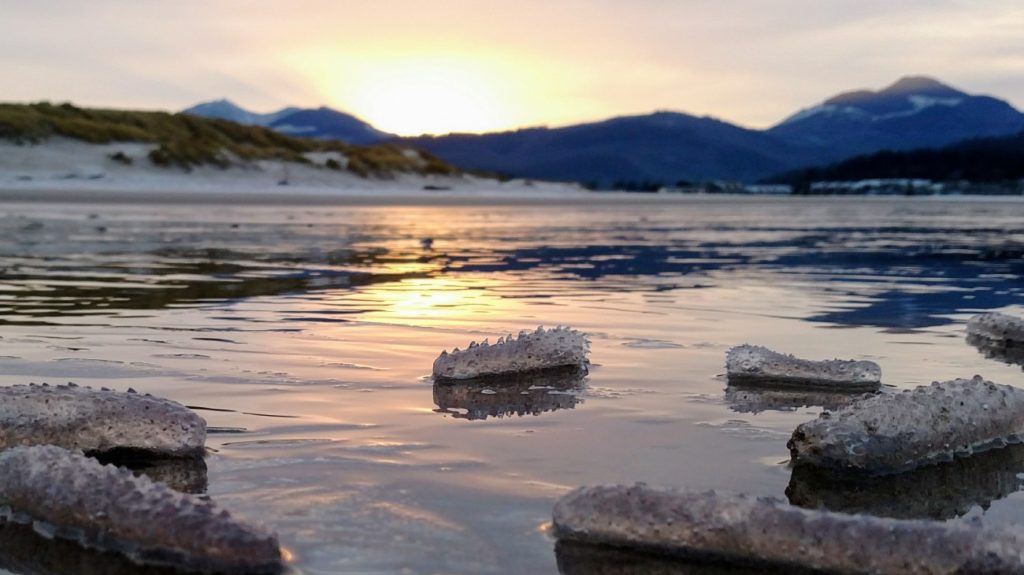For a few years beginning late in 2013, warmer ocean conditions in the eastern Pacific prompted the appearance of unexpected species and toxic algal blooms that devastated others. When temperatures cooled in 2017, the marine ecosystems seemed to be returning to normal. Except for the pyrosomes. Although these previously rare organisms did start to wash up on beaches during the periods of warming, they began to appear by the millions from Oregon to Alaska that spring.
Some combination of ideal conditions led pyrosomes to multiply, dominate the ocean surface and wash up on beaches along the US and Canadian Pacific Coasts. Pyrosomes typically exist offshore, far below the surface in warm, tropical waters all over the world. Their sudden proliferation in other areas is likely due to the warm, Pacific ocean “blob,” although atypical sea currents and changes in pyrosome diet have been offered as other possible explanations.
While the appearance of pyrosomes impeded the efforts of fisherman by clogging nets and filling hooks, greater ecological effects have yet to be observed. As we celebrate World Oceans Month, pyrosomes offer a mesmerizing example of the astounding biological diversity our oceans have to offer and, perhaps, a cautionary tale of the impact climate change can have on those marine lifeforms.
The pyrosome species common in the NE Pacific, Pyrosoma atlanticum, goes by a few other colorful names. Each name reveals something captivating about these creatures. Commonly called “sea pickles” due their size, shape and bumpy texture (like a transparent cucumber), these are not single organisms, but colonies formed by hundreds or thousands of individual multicellular animals call zooids.
These zooids are clones that pack tightly together inside of a structure called a tunic, which is thin, translucent and gelatinous (oozing mucus when handled out of the water). Colonies are tube-shaped with one closed end, resembling a giant, elongated thimble. Usually a few inches to a few feet long, pyrosomes can become astonishingly large, as you can see in this video from the BBC:
Pyrosomes can grow very rapidly, since they reproduce asexually, which requires an efficient feeding strategy. Cilia on the zooid surface beat in unison with the rest of the colony to draw microscopic plankton into their mucous net. Each individual has an incurrent siphon on the exterior of the pyrosome tube and an excurrent siphon in the inside that collectively pump water through the tube for filter feeding. This pumping mechanism also propels the pyrosome fluidly through the water.
The name pyrosome translates to “fire body,” which gives away its most enchanting characteristic—bioluminescence. Sea pickles emit blue-green light when disturbed, which can be visible more than 100 feet away and may deter predators. Compared to other bioluminescent marine animals that produce a brief flash of light, pyrosomes produce a sustained bright glow (New York Times August 2014). The bioluminescent glow from a single zooid can trigger its neighbors in the colony to light up, as well as other pyrosomes in the area.
Ultimately, there is a lot more that we don’t know about pyrosomes, which explains their final nickname, the “unicorn of the sea.” Mysterious and fascinating, there is still so much for ocean researchers to learn about pyrosomes, mostly centered around their role in the ecosystem and impact on the food web. These three questions seem to be the most critical:
- What factors influence their population density? (Perhaps these variables could be used to predict where and when future pyrosome outbreaks might occur.)
- Does their presence negatively impact other species? (In particular, whether or not this recent sea pickles invasion will significantly impact the delicate balance of resources like food and oxygen. Large pyrosome die offs and the resulting decomposition could greatly reduce O2 levels in the water, impacting phytoplankton blooms or harming other marine life.)
- Are they a significant food source for other species? (For example, there is evidence that sea turtles, some bony fish, dolphins and whales eat them. During their population boom in the Northeast Pacific, observations indicated that sablefish (black cod) and chinook salmon may eat them, but it was not clear whether these fish simply couldn’t avoid eating the pyrosomes due to their extreme density.)
So far, researchers observing the recent pyrosome bloom haven’t been able to provide many answers to these fundamental questions. It is also too early to know if sea pickles will persist in the waters of the Pacific Northwest or if their populations with ebb and flow with oceanic warming events. Like other shifts in population and biodiversity related to warming oceans, it is probable that there will be some effect on the ecosystems that the pyrosomes have invaded—but we’ll have to wait and see exactly what the consequences will be.
Latest posts by Darcia Schweitzer (see all)
- Cytochrome P450 Inhibition: Old Drug, New Tricks - May 5, 2022
- Firefly Luciferase Sheds Light on Development of New Malaria Treatments - April 5, 2021
- How to Train Your Instrument Service Team in a Pandemic - February 1, 2021

